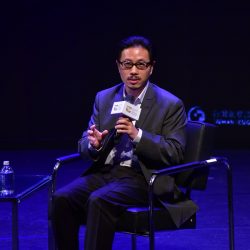FROM DESIGNERS TO MAGAZINES, ESPECIALLY IN CHINESE LANGUAGE-SPEAKING COUNTRIES, PAY EXTRA INTEREST. ALL EYES ARE ON ASIA.
Late November to early December has always been a time when the Asian design industry is particularly enthused with new interesting movements coming out of Hong Kong through the Business of Design Week (BODW) or Taiwan’s The Golden Pin Design Awards. These events have turned Asia into another up-and-coming destination where key players in the industry (product design, in particular) from designers to magazines, especially in Chinese language-speaking countries, pay extra interest. All eyes are on Asia.

Speaker Oki Sato of Nendo on stage at the Golden Pin Design Award 2016 Forum. Sato was also Jury Chair for Golden Pin Design Award 2016 Final Selection.
Apart from the announcement of the winners of The Golden Pin Design Award and The Golden Pin Concept Design Award, in the morning of the same day, the Design Forum was held with an impressive line-up of speakers ranging from Oki Sato of ‘Nendo Design,’ Arthur Huang of ‘MINIWIZ,’ Javin Mo of graphic design studio ‘Milkxhake’ and Swedish designer Marten Claesson of ‘Claesson Koivisto Rune.’ Sato kicked off the show by answering the basic question of ‘What’s design’ through his previous projects and experience. Arthur Huang then took over the stage with many stories of his Taiwan-based multidisciplinary design studio, ‘MNIWIZ,’ whose works encompass architecture, interior and product design. Huang spoke about Recycling Design and the process of re-engineering scrap materials from industrial production into new types of eco-friendly materials. “Re-engineering is not much different from food preparation. We need to have the right material and process so that the result can suit well with the functionality.”

Speaker Arthur Huang of MINIWIZ on stage at the Golden Pin Design Award 2016 Forum.
The stage was then handed over to Javin Mo who provided an overall depiction of editorial design as well as the development changes in the content and design of Design 360,˚ a Guangzhou-based bilingual design magazine, throughout the period from 2006 to 2015. In addition to the impressive layout design, Design 360˚ stands out with the binding technique it employs to hold 3 different sets of publications with respective sizes together while still offering a convenient reading experience. The repositioning of Design 360˚ to be more than just a pure design magazine with contents that revolve around social issues and human living is just as interesting. The approach does not only help to expand the magazine’s reader base, but also projects the image of design as something the general public can relate and have access to. The last speaker was Marten Claesson, who talked about the coincidental similarities between Scandinavian design and Japanese Minimalism, which from his point of view, is the reason why Scandinavian style has become widely popular within the Asian region.
Closing the forum was the panel discussion hosted by Shikuan Chen of Compal Electronics INC where audiences asked questions and exchanged experiences directly with the speakers. Among the questions about working in the studio environment or personal insights about today’s design, a very interesting question was asked, “How can Recycling Design reduce production costs with what seems to be an even more complicated production process?” And Arthur Huang’s answer was just as great. “Comparing the money spent to the environment we will have in return, if you count these natural resources as a part of the production cost, what we are able to save is considered massive.” The very same answer sums it all up as it is a confirmation of how sustainable design’s growing popularity and acceptance bespeak the role of design and its ability to significantly serve the society it is a part of.

Group Photo of Speakers Moderator and other VIPs at the Golden Pin Design Award 2016 Forum. From left to right: Event Host Hsiao Fu-Yuan Hsiao (CommonWealth Magazine); Panel Moderator Shikuan Chen (Compal Electronics Inc.); Speaker Arthur Huang (MINIWIZ); Speaker Javin Mo (Milkxhake); Speaker Oki Sato (Nendo); Speaker Mårten Claesson (Claesson Koivisto Rune); and Nina Ay (Taiwan Design Center).




